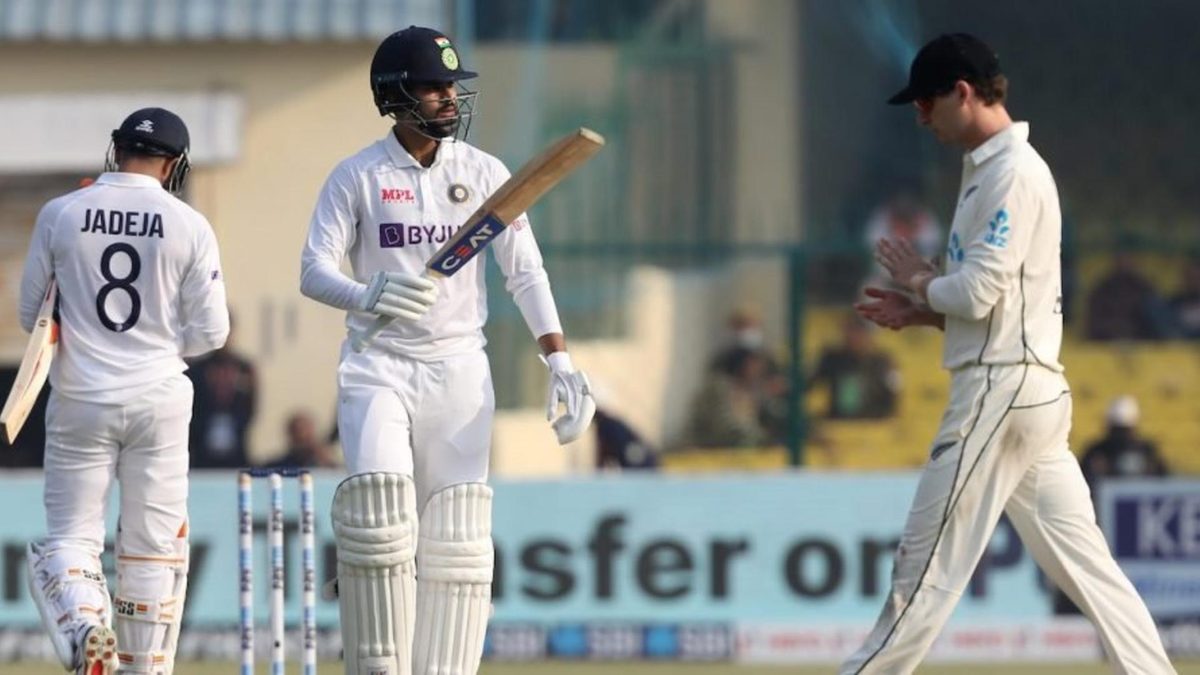
Earning his long-awaited Test debut in the India-New Zealand Kanpur Test, Shreyas Iyer ended day one unbeaten on 75. As things go, the knock, while signalling the start of what could be a promising career, could also intensify the growing pressure on the underfire Ajinkya Rahane.
It’s been a long wait for Iyer. Four and a half years ago, he was called up as a replacement for the injured Virat Kohli, added to the Test squad during Australia’s visit to India. Kohli had been sidelined with a shoulder injury, but the middle order had enough resources to fill the gap, leaving Iyer part of the standby squad.
On Monday, Iyer, himself having recovered from a long shoulder injury, finally broke into the middle order, filling in for Kohli again. He would have been well aware that the India captain will return to reclaim his No.4 spot in ten days’ time, and chances such as these won’t come easy. He pipped his first first-class captain, Suryakumar Yadav, to the spot, ending his first day in the India whites with 75 well-crafted runs next to his name.
The day before, skipper Ajinkya Rahane had confirmed that Iyer was set to debut, a confirmation rarely given in Indian cricket with captains preferring to keep their cards close to their chest.
Along with Rahane then, the New Zealand team would have had a day to revise their plans on Iyer, but the unfamiliarity of facing a new-age, intent-filled batter would have somehow felt more challenging than bowling to the rusty-looking stand-in captain.
Ahead of the game, Rahane, under fire from several quarters, had said that he’s not concerned about his form, saying it’s not always about scoring hundreds. And while that might be a healthy, philosophical way of looking at his rough patch, one also wonders how long it’ll be until either Rahane or the management acknowledge that the runs have thinned to the extent of taking a drastic step.
Iyer came into the line-up like a breath of fresh air for those who have been accustomed to the same Indian middle order for the last decade. Unafraid to get going from the start, he let his natural game lay the groundwork, hoisting the ball over the in-field to force defensive fields.
By the end of the day, he was unbeaten on 75, having rallied with Jadeja to flatten the Kiwi attack, seven fours and two sixes included. There was fluidity in his game, the gall to take risks against spinners on a seemingly two-paced debut wicket, and also the awareness to slow down when needed, quietly taking up the consolidating role.
The reason why it all sounds so appealing is that India’s middle order has often been found to be scratchily defensive, batting themselves into a rut before giving away their wicket after a half-baked innings. Rahane has been a big reason of worry himself: he has hit just two half-centuries this year, often losing his wicket just when you think he’s settling down well.
In a team that has become so used to seeing Pujara and Rahane struggle for notable scores of late, watching Iyer bat was refreshing to see. It opened up one’s eyes to what the future can be if the present can be changed a bit. The same day Iyer scored 75*, Rahane chased one outside off to end on 35, much lower than what some of his shots promised. His career average, too, fell below 40 – among Indian batters, only Kapil Dev and MS Dhoni have scored more runs at a lower average, and they had other skills to justify their places in the side.
When Kohli comes back in Mumbai, ironically the home ground of both Iyer and Rahane, one of those two will have to make way. Being the stand-in captain, Rahane can’t be shelved easily, but Iyer’s flair has perhaps opened a long-closed door, and you can almost see a bright future on the other side. Iyer is seven years younger than Rahane, and as India look to turn their current dominance into an all-powerful era, bringing in young players at the right time will be key.
There’s another Mumbaikar in Suryakumar Yadav quietly waiting. He’s been around even longer than Iyer. The new duo might not be finished red-ball products, but you won’t learn anything by keeping them on the benches. Iyer’s knock might have come against a limited attack in familiar conditions, but it’s a start that one needs to see more of.
It’s probably time the door is pushed open even further.








